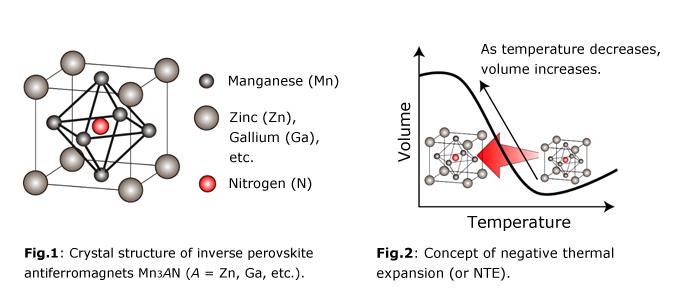A step closer to developing more durable and less heat-sensitive machine parts

Credit: Waseda University
If you have tried dismantling your own computer, cell phone or any other devices, you will find that the inside of such machines are made up of many small parts and components that are prone to poor performance and damage caused by overheating. As such, there is constantly a market demand to develop machine parts that could resist damage and changes (e.g. changes in size and length) due to heat.
Back in junior high or high school, many of us would have learned in science classes that materials expand upon heating and contract upon cooling. In reality, some materials behave the other way around, i.e. expanding upon cooling and vice-versa, an unusual phenomenon known as negative thermal expansion (NTE). NTE materials have thus come under the spotlight worldwide because by utilizing their characteristics and using them in combination with non-NTE materials, developers could make materials that are even less heat-sensitive than before. Unfortunately, the mechanism behind NTE had remained unknown to scientists and developers over the past 40 years.
However, for the first time, a recent study led by Professor Masahito Mochizuki at Waseda University and graduate student Masaya Kobayashi from Aoyama Gakuin University was able to provide a theoretical explanation to the NTE phenomenon by examining NTE observed in inverse perovskite antiferromagnets Mn3AN (A = Zn, Ga, etc.). The theory could not only help scientists and developers understand the mechanism behind NTE, but also allow them to predict and identify possible candidate materials that would exhibit NTE–a crucial process in research and development.
An electron has an angular momentum called “spin” originating from its rotation. During cooling, the spin vectors of electrons that orbit around the manganese (Mn) ion present in Mn3AN would align themselves in a specific fashion called “nonplanar antiferromagnetic order”. It has been known that as temperature decreases, the Mn3AN material would expand in volume. Believing that there is a close relationship between the electron spin alignment and negative thermal expansion phenomena in Mn3AN, Professor Mochizuki and his team decided to investigate the correlations between the two to understand the NTE mechanism by numerically reproducing the crystal-volume expansion upon cooling triggered by the nonplanar antiferromagnetic order.
“In our study of inverse perovskite antiferromagnets Mn3AN, we have revealed that the mechanism is not specific to the inverse perovskites but might be expected in other crystal structures. Specifically, antiferromagnets in which antiferromagnetic contribution from direct exchange paths and ferromagnetic contribution from indirect 90 degree paths compete severely with each other are potential candidates that could exhibit NTE,” says Professor Mochizuki.
Professor Mochizuki and his team believe that the above prediction will be a useful guide to search for new NTE materials because there is no reliable way to seek or identify magnetism-driven NTE materials at present.
“Although the existence of such competition is not a sufficient condition but a necessary condition for emergence of the magnetism-driven NTE, search for compounds that satisfy this condition is a strong strategy to discover new NTE materials with profound effects.” adds Professor Mochizuki.
###
A paper on this study was published in Physical Review Materials on February 21, 2019.
University news on this study: https:/
About the published article
Published in Physical Review Materials on February 21, 2019
Title: Theory of magnetism-driven negative thermal expansion in inverse perovskite antiferromagnets
Authors: Mochizuki Masahito & Masaya Kobayashi
DOI: https:/
About Waseda University
Located in the heart of Tokyo, Waseda University is a leading private research university which has long been dedicated to academic excellence, innovative research and civic engagement at both the local and global levels. With its pioneering spirit, the university brings inspiration and new knowledge to the world through its creations and discoveries.
Waseda has produced countless leaders in their respective fields since its founding in 1882, including seven prime ministers, the founders and CEOs of multinational companies, Olympic and Paralympic medalists and internationally-acclaimed writers.
Today, the student body at Waseda is approximately 50,000, over 7,000 of whom are from overseas, hailing from 120 countries. The university takes great pride in its tradition of open-mindedness and inclusivity of diverse groups of people, for Waseda believes that the plurality of ideas and perspectives can bring positive change for a brighter, more sustainable future in the ever-changing world.
Media Contact
Jasper Lam
[email protected]
Original Source
https:/




